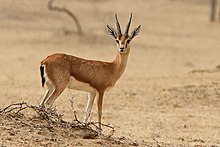| Desert National Park | |
|---|---|
| Nearest city | Jaisalmer, Barmer |
| Coordinates | 26°00′N 70°30′E / 26°N 70.5°E |
| Area | 3,162 km2 (1,221 sq mi) |
| Established | 1981 |
Desert National Park is a national park in the Indian state of Rajasthan, near the towns of Jaisalmer and Barmer. It is one of the largest national parks, covering an area of 3,162 km2 (1,221 sq mi) in the Thar Desert. Sand dunes form around 44% of the park. The major landform consists of craggy rocks and compact salt lake bottoms, intermedial areas and fixed dunes. It was gazetted in 1980.
Despite a fragile ecosystem, it harbours an abundance of birdlife, both migratory and resident birds, including short-toed eagle, tawny eagle, spotted eagle, laggar falcon, kestrel, sand grouse and great Indian bustard. Desert National Park has a collection of fossils of animals and plants which are 180 million years old. Some fossils of dinosaurs which are 60 million years old were found in the area.[1]
Geography and location[edit]
Desert National Park covers an area of 3,162 km2 (1,221 sq mi), of which 1,900 km2 (730 sq mi) is in Jaisalmer district and the remaining 1,262 km2 (487 sq mi) in Barmer district of Rajasthan. It mostly consists of sand dunes (44%), but also has pediments, pavements and structural plains. Fossils from the Jurassic Period were found in side the park.[2]
Fauna[edit]



The Chinkara (Gazella bennettii) is a common antelope of this region. The national park's other notable inhabitants are the desert fox, wolf and desert cat. Birdlife in this sandy habitat is vivid and spectacular. Birds such as sandgrouse, partridges, bee-eaters, larks, and shrikes are commonly seen. In the winter, the birdlife is augmented by species such as the demoiselle crane and MacQueen's bustard.
Perhaps the greatest attraction of the park is a bird called the great Indian bustard, a critically endangered species found only in India. Desert National Park is one of the last sites in which this species can be found in good numbers. As such, the species draws in thousands of birdwatchers from all over the world. In addition to the great Indian bustard, the park supports a variety of other birds of interest to birdwatchers and conservationists alike.
The Thar Desert, often called an 'ocean of sand', covers a large area of western Rajasthan. The fragile ecosystem of the Thar supports unique and varied wildlife. In this vast ocean of sands lies the famous Desert National Park, which provides an excellent example of the ecosystem of the Thar Desert and its diverse wildlife adventure.
The vegetation is sparse, and patches of sewan grass and aak shrub Calotropis occur. The landscape includes craggy rocks and compact salt lake bottoms, as well as intermediate areas and both fixed and shifting dunes. Around 20 percent of the vast expanse is covered with sand dunes.
Mammals: desert fox, Bengal fox, desert cat, wolf, hedgehog, chinkara]
Reptiles: spiny-tailed lizard, monitor lizard, saw-scaled viper, Russell's viper, common krait.
Avifauna: sandgrouse, Indian bustard, partridges, bee-eaters, larks and shrikes are year-round residents, while demoiselle crane and houbara bustard arrive in winter. Raptors include tawny and steppe eagles, long-legged and honey buzzards, and falcons.[3]
Flora[edit]
Habitats that are found in the park include open grassland, thorny bushes, and dunes. 168 plant species have been recorded in the park.[2] Some species of trees that inhabit the park include Tecomella undulata, Moringa concanensis, Helitropium rariflorum, and Ammannie desertorum.[2]
See also[edit]
References[edit]
- ^ Gupta, M.L. (2008). Rajasthan Jyankosh, Rajasthani Granthagar. Jodhpur. p. 216. ISBN 81-86103-05-8.
{{cite book}}: CS1 maint: location missing publisher (link) - ^ a b c "Desert National Park". UNESCO World Heritage Centre. Retrieved 7 July 2022.
- ^ Khan, A.N. (2015). "Birding in North-West India". Buceros. 20 (1): 10–17.

